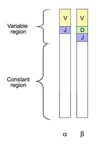TCR and MHC Flashcards
1
Q
MHC-restricted Antigen Recognition
A
T cell recognition requires TCR to recognize both:
1) self-MHC
2) peptide antigen
T cells are unable to recognize native or free antigens.

2
Q
T Cell
Receptor Complex
A
- TCR are disulfide-linked heterodimers
- αβ (alpha/beta chains)
- most common TCR type
- γδ (gamma/delta chains)
- first TCR made during embryonic development
- minority, found predominantly at mucosal sites
- αβ (alpha/beta chains)
- TCR non-convalently linked to CD3 and ζ-proteins (zeta)
- Variable region of αβ subunits contact MHC and Ag complex
- CD3 and ζ-chains transmit the signal into the cell
- T-cells can be identified by CD3 expression

3
Q
TCR
Structure and Genes
A
- TCR polypeptides consists of two major domains:
- constant region
-
variable region
- Interacts with Ag/MHC
- Composed of multiple gene segments assembled through gene rearrangement
-
α (and γ): V and J gene segments
- Similar to BCR light chain
-
β (and δ): V, D, and J gene segments
- Similar to BCR heavy chain
- Joining region between the alpha and beta chains is where Ag binds

4
Q
TCR
Rearrangement
A
- Gene rearrangement occurs in the absence of Ag
- Events are random
- Allelic exclusion prevents both loci or two different TCRs from being expressed in a cell
- Utilizes similar components as BCR rearragement:
- V(D)J recombinase
- Exonucelases
- TdT
- T-cells do not undergo somatic mutation after activation

5
Q
TCR
Mechanisms of Diversity
A
- Multiple V, D, and J segments
- Combinatorial diversity
- V, (D), and J gene segment combinations
- α and β chain combinations
- Diversity gene segments (D) code in all three reading frames
- Junctional diversity
- Exonucleases
- TdT
T cells do not undergo:
- Somatic mutation
- Isotype switching
- Affinity maturation
6
Q
HLA Locus
A
HLA (Human Leukocyte Antigens) locus composed of many linked genes on chromosome 6.
One of the most gene dense regions with > 100 genes.
Usually inherited as a group = haplotype.

7
Q
Class I MHC
Genes
A
- Encoded by HLA-A, HLA-B, and HLA-C genes
- Expresssed on almost all nucleated cells
- Absent or minimal on:
- brain
- sperm
- placental trophoblasts
- early embryos
- Absent or minimal on:
- Expression upregulated by:
- Type I IFN’s (IFN-α and IFN-β)

8
Q
Class II MHC
Genes
A
- Encoded by HLA-DR, HLA-DP, HLA-DQ
- Expressed on:
-
Professional antigen presenting cells
- Mature B cells
- Activated macrophages
- Dendritic cells
-
Professional antigen presenting cells
- Inducible on activated macrophages, some activated epithelial/endothelial cells, and others
- Expression upregluated by type 2 IFN (IFN-γ)

9
Q
Class III MHC
A
- Are NOT antigen presenting complexes
- Encode several secreted proteins associated with immune response
- complement
- TNF
10
Q
MHC Alleles
A
- MHC loci are highly polymorphic
- In the hopes that some individuals within a population has MHC able to recognize all pathogens
- HLA alleles are codominantly expressed
- One from each parent
- A single cell expresses multiple class I and II products on cell surface
- Generally inherited as a group called a haplotype
- 1/4 of siblings will share the same haplotype
- Strongly linked to autoimmune diseases
11
Q
Class I MHC
Structure
A
- Four immunoglobulin domains
- Each MHC polymer noncovalently attached to a β2-microglobulin
- β2-microglobulin is not encoded by the MHC gene
- More conserved
- CD8 on T-cell can bind to a conserved region of the molecule

12
Q
Class II MHC Structure
A
- Each MHC II composed of non-covalently linked α-chain and β-chain dimers
- Forms four Ig domains
- CD4 can bind to a conserved region of the molecule

13
Q
MHC
Peptide-Binding Groove
A
- Both class I and II binding grooves formed by 8 anti-parallel β strands with two α-helical bridges
- Like a hotdog (β strands) in a bun (α-helices)
- Groove binds short 8-18 AA chains (T-cell epitope) from the antigen
- Most MHC diversity exists in the groove
- MHC restriction of Ag recognition: when TCR engages it recognizes both the MHC’s α-helical bridges and the peptide lying in the groove
- Epitope/MHC combination specific
- Can require several different TCR’s to recognize the same epitope due to varrying MHC’s
14
Q
MHC
Promiscuous Binding
A
- Each individual has only 6 MHC genes which must present all necessary antigenic peptides to T-cell for activation.
-
Peptide display is not as specific as the Ag recognition system used by TCR or BCR.
- Allows each MHC molecule to present multiple peptides.
-
Requirements for MHC binding:
-
Length
- MHC I likes shorter peptides
- MHC II likes longer peptides
-
Anchor residues
- conserved peptide residues that secure the peptide into the peptide-binding groove
- Usually 9 AA in length with specific AA at certain positions.
-
Length



